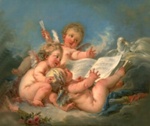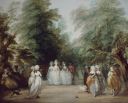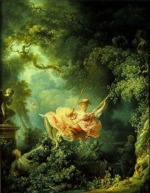

Jean-Antoine Watteau (French, 1684-1721) is often referred to as the greatest of the Rococo painters, and his picture of the Embarkation for Cythera demonstrates the elegance of this style.
The Rococo is sometimes considered
a final phase of the Baroque
period.
Examples of works of this period are:
Jean Thierry (French, 1669-1739)

Jean-Antoine Watteau (French, 1684-1721),
Savoyard with a Marmot, 1716, oil
on canvas, 16 x 13 inches
(40.5 x 32.5 cm), Hermitage Museum, St. Petersburg, Russia.
Jean-Antoine Watteau, Two Studies of a Flutist and a Study of the Head of a Boy, about 1716-1719, red, black, and white chalk on buff-colored paper, 8 7/16 x 13 3/16 inches (21.4 x 33.6 cm), J. Paul Getty Museum, Malibu, CA. See trois crayons.

Jean-Antoine Watteau, Mezzetin, probably 1718-20, oil
on canvas, 21 3/4 x 17
inches (55.2 x 43.2 cm), Metropolitan Museum of Art, NY. (On
the Met's page, you can enlarge any detail.)

Giovanni Battista Tiepolo (Italian, Venetian,
1696-1770), Maecenas Presenting the Liberal Arts to Emperor
Augustus, c. 1745, oil
on canvas, 27 x 35 inches
(69.5 x 89 cm), Hermitage Museum, St. Petersburg, Russia.

Giovanni Battista Tiepolo, The Chariot of Aurora, oil
on canvas, 35 1/2 x 28
5/8 inches (90.2 x 72.7 cm), Metropolitan Museum of Art, NY.
This is a sketch made
as a proposal for a painting on a ceiling in the Royal Palace
in Madrid. The ceiling was eventually painted, but by a rival.

Giovanni Battista Tiepolo, Allegory of the Planets and Continents,
sketch, 1752, oil
on canvas, 73 x 54 7/8
inches (185.4 x 139.4 cm), Metropolitan Museum of Art, NY. (On
the Met's page, you can enlarge any detail.)
Canaletto (Giovanni Antonio Canal) (Italian, 1697-1768).
Jean-Baptiste Siméon Chardin (French, 1699-1779)
Lambert-Sigisbert Adam (French, 1700-1759)
François Boucher (French, 1703-1770)

François Boucher, The Toilet of Venus, 1751, oil
on canvas, 42 5/8 x 33
1/2 inches (108.3 x 85.1 cm), Metropolitan Museum of Art, NY.
(On the Met's page, you can enlarge any detail.) See mythology and nude.

François Boucher (French, 1703-1770), Allegory of Music, 1752, oil on canvas, 26 1/2 x 30 inches (67.3 x 76.2 cm), North Carolina Art Museum, Raleigh. See allegory and music.

François Boucher, Cupid a Captive, c. 1754, oil
on canvas, relined, 164.5
x 84.5 cm, Wallace Collection, London.

François Boucher (French, 1703-1770),
Shepherd and Shepherdess Reposing (The School
of Love), 1761, oil
on canvas, relined, 76.6
x 63.6 cm, Wallace Collection, London. See oval.
Maurice Quentin de La Tour (French, 1704-1788)
Jean-Baptiste Pigalle (French, 1714-1785)
Jean-Baptiste Perronneau (French, 1715-1783)
Etienne-Maurice Falconet (French, 1716-1791)

Etienne-Maurice Falconet, Winter, 1771, marble,
height 135 cm, Hermitage
Museum, St. Petersburg, Russia. See drapery.
Giovanni Battista Piranesi (Italian, 1720-1778 ).

Jean-Baptiste Greuze (French, 1725-1805),
The Paralytic, oil
on canvas, 115.5 x 146
cm, Hermitage Museum, St. Petersburg, Russia.

Thomas Gainsborough (English, 1727-1788), The Mall in St. James's Park, c. 1783, oil
on canvas, 47 1/2 x 57
7/8 inches (120.6 x 147 cm), Frick Collection, NY.
![]()
Thomas Gainsborough, London, A Lady Walking in a Garden with a Child,
about 1785, black chalk
with stumping on light
brown paper, heightened
with white pastel,
20 x 8 11/16 inches (50.5 x 22.1 cm), J. Paul Getty Museum, Malibu,
CA.
French, Astronomical Clock, c.1750, Wallace Collection, London. The movement was designed by Fortier and made by Stollewerck; the patinated-bronze figures are possibly by J. Caffiéri. The principal clock-face now shows Greenwich mean time (blued-steel hand) and apparent solar time (gilt hand); from the central dial can be read the passage of the sun across the Zodiac, the age, longitude and phases of the moon, and the time anywhere in the northern hemisphere (a map of which is engraved on the revolving circular plate); the two lowest dials show the rising and setting of the sun (left) and moon (right).
![]()
After designs by Pierre Contant d'Ivry, architect, French, Paris, 1756,
Wall Lights, gilt
bronze, 3 feet x 1 foot 9 inches
x 1 foot 2 inches (91.5 x 53.0 x 35.0 cm), J. Paul Getty Museum,
Malibu, CA.

Jean-Honoré Fragonard (French, 1732-1806),
The Stolen Kiss, oil
on canvas, 45 x 55 cm,
Hermitage Museum, St. Petersburg, Russia.

Jean-Honoré Fragonard, The Swing, 1767, oil
on canvas, Wallace Collection,
London. The exuberance of The Swing has come to epitomize
Rococo painting. It depicts
a fashionably dressed lady revealing her charms to her lover,
carefully positioned in a bed of roses; the lady's husband is
an unwitting accomplice to this act of amorous intrigue.
Jean-Honoré Fragonard, The Progress of Love, ten panels: four painted in 1771-73, six painted in 1790-91, oil on canvas, heights of the taller panels c. 125 inches (317.5 cm), of the four overdoors c. 59 inches (150 cm), with varied widths, Frick Collection, NY.
![]()
Claude Michel, "Clodion" (French,
1738-1814), Vestal Presenting a Young Woman at the Altar
of Pan, about 1770-1775, terra
cotta, height excluding
base 17 3/4 inches (45
cm), J. Paul Getty Museum, Malibu, CA.
Also see chinoiserie, fête galante, and kitsch.
https://inform.quest/_art